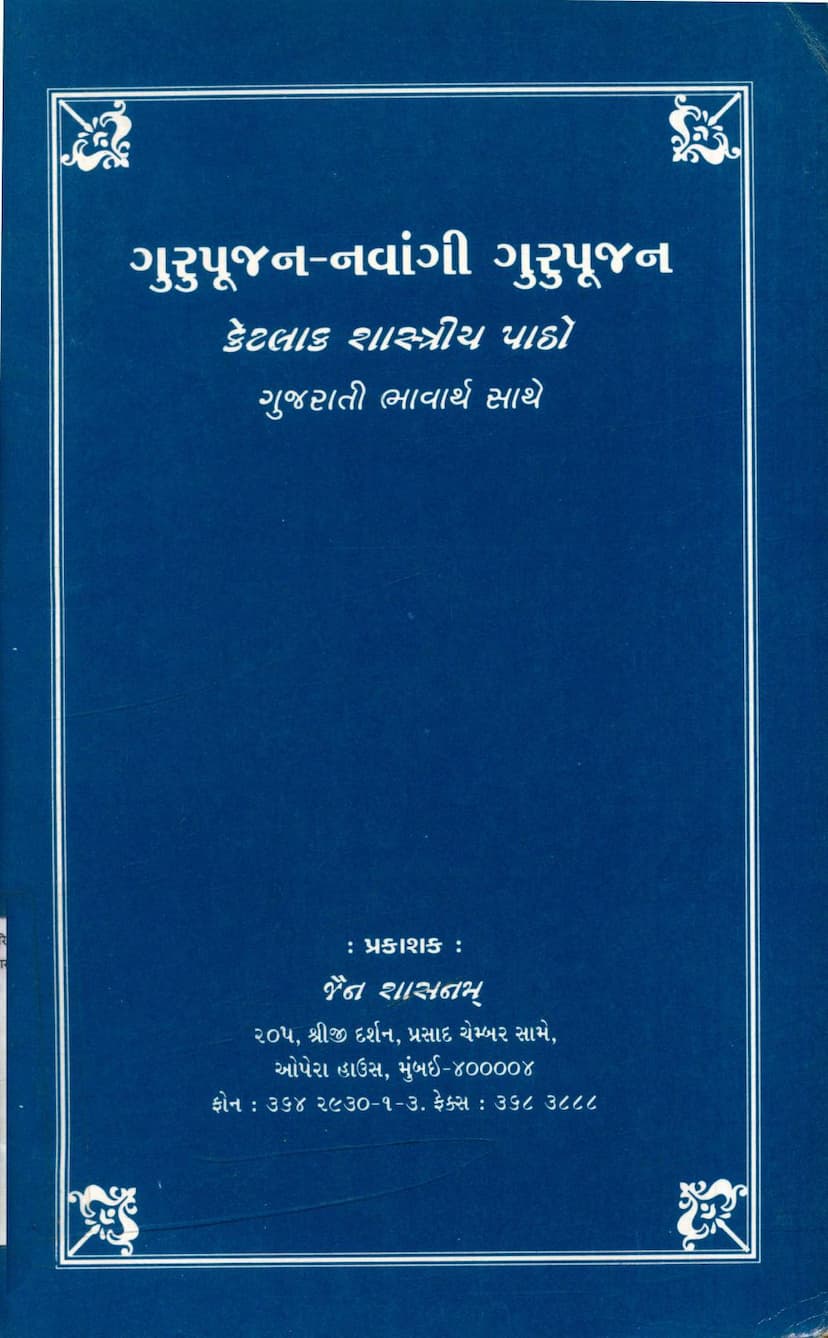Gurupujan Navangi Gurupujan Ketlak Shastriya Patho
Added to library: September 1, 2025

Summary
Here is a comprehensive summary of the Jain text "Gurupujan Navangi Gurupujan Ketlak Shastriya Patho" based on the provided pages:
Book Title: Gurupujan Navangi Gurupujan Ketlak Shastriya Patho (Gurupujan, Navangi Gurupujan, and Some Scriptural Passages with Gujarati Meanings)
Author/Publisher: Jain Shasanam (Publishers: Jain Shashvatam)
Core Theme: This book is a defense and compilation of scriptural evidence supporting the practice of Navangi Gurupujan (worship of the guru's nine limbs) within Jainism. It aims to address doubts and counter misinformation that has arisen in some sections of the Jain community regarding the scriptural validity and propriety of this practice.
Key Arguments and Content:
-
Reaffirmation of Scriptural Basis: The primary assertion of the book is that Navangi Gurupujan is entirely based on scriptures and that no one has the right to alter this scriptural command, as the context and time periods have not changed in a way that necessitates modification.
-
Addressing Doubts and Misconceptions: The book acknowledges that there are doubts and a "cloud of suspicion" being created by certain groups against the practice of Navangi Gurupujan. It contends that these arguments are baseless and an attempt to misrepresent those who strictly follow scriptural practices.
-
Inclusion of Prominent Acharyas: The book highlights that prominent and respected Acharyas from the Tapa Gaccha lineage, such as Acharya Shri Vijay Dansurishwarji Maharaj, Jagadguru Acharya Shri Hiravijaysurishwarji Maharaj, and Acharya Shri Vijaydevsurishwarji Maharaj (and his successor Acharya Shri Vijaysurishwarji Maharaj), have upheld this tradition. It also states that most senior Acharyas in the current Jain monastic order have never renounced or allowed the renunciation of this scriptural practice and have supported those who follow it.
-
Historical Evidence and Examples: The book provides numerous examples and references from various Jain scriptures and historical accounts to demonstrate the practice of Navangi Gurupujan. These include:
-
Scriptural References:
- Sambodh Shattari and Sambodh Prakaran by Acharya Shri Haribhadra Suri, which equate Acharyas with Tirthankaras and discuss their worship.
- Acharaanga Sutra (and its commentary by Acharya Shri Shilankacharya) is cited, mentioning sampujanam (worship) with fragrant substances like kasturi, kapoor, chandan, and agaru as a darshan bhavna (devotional practice) for Tirthankaras, Acharyas, Yugapradhanas, and other accomplished souls.
- Nishesh Siddhant Vichar Paryay by Gani Chakrakirti, referencing Acharaanga, supports guru worship with fragrant substances and approaching the guru.
- Achara Dinkara by Acharya Shri Vardhmansuriji, which mandates bowing and worshipping saints like deities.
- Chaturmasi Vyakhyan Granth by Acharya Vijaylakshmisuriji, mentioning anga-puja (limb worship) before listening to discourses.
- Panchashak by Acharya Shri Haribhadra Suri, lists "interest in guru puja" as a necessary quality for one who builds a Jain temple.
- Pratishtha Kalpa, Jimb Pravesh Vidhi, Jain Pratishtha Vidhisth are cited for specific instructions on Navangi Gurupujan, often involving nine gold or silver coins.
- Dravya Saptatika is presented as a key text that establishes the worship of a guru's limbs and forefront, similar to that of Jinas.
- Heer Prashnottarani, a compilation of questions and answers, discusses guru worship with gold and other materials and their use.
- Dharmasangraha by Upadhyay Shri Manvijaygani, clarifies the nature of guru-dravya (property related to the guru).
- Shatrunjaya Mahatmya by Dhaneshwarsuri and Hansaratnasuri, describes Bharat Chakravarti performing padapuja (foot worship) and chandan-puja of his guru.
- Bhavishyadaatt Charitra by Megh Vijayganni, mentions the worship of sage Vimlabuddhi's body with sandalwood, agaru, kasturi, saffron, gold, gems, and pearls.
- Surishwar aur Samrat (Suri and the Emperor) quotes instances of worship of Jagadguru Hirsuriji Maharaj with gold coins.
- Kumarpal Charitra (Hindi) describes King Kumarpal's devotion and intent to worship Hirsuriji's feet with gold lotuses.
- Hirpragnanuvad, a text verified by Acharya Shri Vijaypremsurishwarji Maharaj, clearly states that guru worship is scriptural and the associated wealth goes to devadravya (wealth for deities) and cannot be used by monks.
- Jain Parampara Ka Itihas (History of Jain Tradition) by Bandhu Triputi provides historical accounts of Navangi Gurupujan in various Gacchas (sects) and by prominent figures like Tejpal.
- Shri Shripal Charitra by Muni Jaykirti mentions navarangapuja (nine-limbed worship).
- Shri Prashasti Sangrah details Tejpal's extensive Navangi Gurupujan of various monks in Ahmedabad.
- Jagatguru Kavya describes Navangi Gurupujan with gold coins performed by devotees in Patan.
- Vijay Prashasti Mahakavya recounts Navangi Gurupujan with gold coins for Jagadguru Hirsurishwarji Maharaj on Shatrunjaya.
- Dhanya Charitra by Gyan Sagargani describes Navangi Gurupujan of Rishi Somil.
-
Visual Evidence (Photographs): The book includes photographs illustrating Navangi Gurupujan ceremonies of various revered Acharyas like Acharya Shri Vijaypremsurishwarji Maharaj and Acharya Shri Vijaykalapurna Suriji Maharaj, with devotees performing the worship.
-
-
Nature of Guru-Dravya: The text clarifies that money or gold used in guru puja is not considered guru-dravya (personal property of the guru) if it's not dedicated by the guru for their own use. Instead, such offerings are meant for the upkeep and renovation of temples and religious activities, aligning with devadravya. However, the text also notes that in the context of worship, this money does become guru-dravya.
-
Inclusivity of Practice: The book emphasizes that the practice is not limited to Tapa Gaccha but is also found in other major Gacchas like Kharatar Gaccha and Anchal Gaccha. It also confirms that women can perform Navangi Gurupujan.
-
Purpose of the Book: The editors express their wish that by calmly considering these scriptural and historical references without prejudice, people will abandon opposition to Navangi Gurupujan and embrace this beneficial practice that upholds the honor of the guru and the Jain tradition.
In summary, the book "Gurupujan Navangi Gurupujan Ketlak Shastriya Patho" serves as a comprehensive scriptural and historical defense of the practice of Navangi Gurupujan within Jainism. It aims to dispel doubts by presenting a wealth of evidence from ancient texts, commentaries, and historical accounts, demonstrating that this form of guru worship is well-established, scripturally sanctioned, and has been consistently practiced by revered Acharyas and devotees across various Jain traditions.